Click on images to enlarge
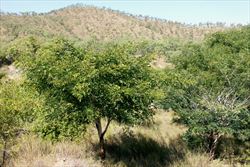
infestation in northern Queensland (Photo: Chris Gardiner)

habit in flower (Photo: Sheldon Navie)
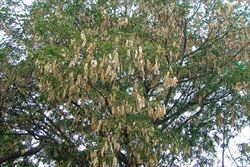
habit in fruit (Photo: Sheldon Navie)
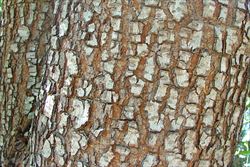
rough greyish-brown bark of older tree (Photo: Sheldon Navie)
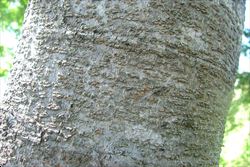
smooth grey bark of younger tree (Photo: Sheldon Navie)

young branch showing raised glands near the bases of the thick leaf stalks (Photo: Sheldon Navie)

twice-compound leaf (Photo: Sheldon Navie)
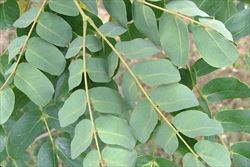
close-up of leaflet undersides (Photo: Sheldon Navie)

fluffy, globular, flower cluster (Photo: Sheldon Navie)

immature fruit (Photo: Sheldon Navie)
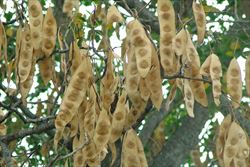
mature fruit (Photo: Sheldon Navie)

close-up of mature fruit with seeds (Photo: Sheldon Navie)

sapling naturalised along Enoggera Creek in Ashgrove (Photo: Sheldon Navie)
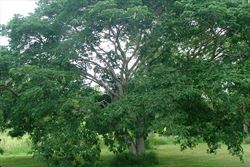
spreading habit (Photo: Sheldon Navie)
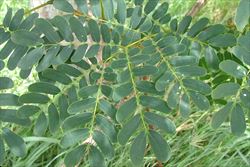
large twice-compound leaf (Photo: Sheldon Navie)
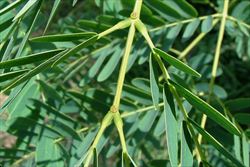
smaller raised glands at the junction of the leaf branchlets (Photo: Sheldon Navie)
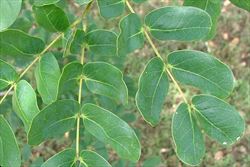
close-up of large leaflets (Photo: Sheldon Navie)
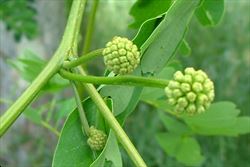
young flower clusters borne on stalks in a leaf fork (Photo: Sheldon Navie)
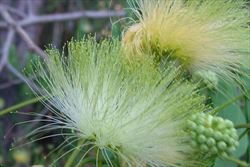
close-up of greenish-white flowers, with older yellowish flowers in the background (Photo: Sheldon Navie)

close-up of straw-coloured mature fruit (Photo: Sheldon Navie)
Scientific Name
Albizia lebbeck (L.) Benth.
Synonyms
Acacia lebbeck (L.) Willd.Albizia latifolia BoivinAlbizia lebbeck (L.) Benth. var. pubescens Benth.Feuilleea lebbeck (L.) KuntzeMimosa lebbeckL.
Family
Fabaceae: sub-family Mimosoideae (New South Wales)Leguminosae (South Australia)Mimosaceae (Queensland, the ACT, Victoria, Tasmania, Western Australia and the Northern Territory)
Common Names
albizia, East Indian walnut, frywood, Indian albizia, Indian siris, Indian siris tree, koko, lebbeck tree, lebbek, lebbektree, rain tree, raintree, raom tree, shack-shack, silver raintree, singer-tree, siris, siris rain tree, siris tree, siris-tree, siristree, soros-tree, Tibet lebbeck, white siris, woman's tongue, woman's tongue tree
Origin
This species is probably native to southern and south-eastern Asia and northern Australia, and possibly also parts of eastern Africa. Because it is widely cultivated and naturalised in the tropical regions of the world (i.e. pan-tropical), its exact origin is somewhat obscure.
In northern Australia, Indian siris (Albizia lebbeck) is considered to be native to northern Western Australia (i.e. the Kimberley region), the northern parts of the Northern Territory, and far northern Queensland (i.e. the Cook pastoral district).
Naturalised Distribution
Indian siris (Albizia lebbeck) is widely naturalised beyond its native range in many parts of northern and eastern Queensland (i.e. in the Burke, North Kennedy, South Kennedy, Port Curtis, Leichhardt, Wide Bay, Burnett and Moreton pastoral districts). It is possibly also naturalised beyond its native range in Western Australia and the Northern Territory.
Also naturalised in Africa, tropical South America, southern USA (i.e. California, Texas and Florida), the Caribbean, La Réunion and on some Pacific islands (i.e. the Cook Islands, Fiji, Tonga, New Caledonia and Hawaii).
Notes
This species is thought to occur naturally in coastal forests, monsoonal vine thickets, savannah woodlands and riparian areas in some parts of northern Australia, though it may be a relatively recent introduction to these regions. However, it is also widely cultivated in other parts of Australia and has recently become naturalised in other regions.
Indian siris (Albizia lebbeck) is regarded as an environmental weed in those parts of Queensland that are outside its probable native range. It is currently of most concern in the coastal and sub-coastal districts of northern and central Queensland. This species prefers the wet-dry monsoonal climate of northern Australia and it is particularly aggressive around Townsville and Charters Towers. It grows on hillslopes, in open woodlands, in vine thickets, and along streambanks in the Townsville region and is thought to pose an environmental threat to the native vegetation on Castle Hill, within Townsville City. The nearby Thuringowa City Council considers this species to be an "undesirable" plant in or near natural areas. Further inland, the Charters Towers City Council lists Indian siris (Albizia lebbeck) as a high priority species in its pest management plan, and this weed is said to spread rapidly and restrict the growth of native species in this local authority area.
In more recent years, Indian siris (Albizia lebbeck) has continued to spread southwards and is becoming more common in south-eastern Queensland. It is now regarded as an environmental weed by some local authorities in this region (e.g. Redlands Shire, Ipswich City and Hervey Bay City). It is sometimes also regarded as an environmental weed in some parts of northern and north-western Western Australia.
Indian siris (Albizia lebbeck) is also a significant weed in Florida, in south-eastern USA, where it is a fast-growing coloniser of disturbed areas. By 1933, this species was noticed to be invading tropical hammock forests in the Florida Keys. It is now common in the central and southern parts of Florida and has been reported from conservation areas in this region (e.g. in the Big Cypress National Preserve and the Everglades National Park). It is also also naturalised on moist and dry coastal hillsides in Puerto Rico.

